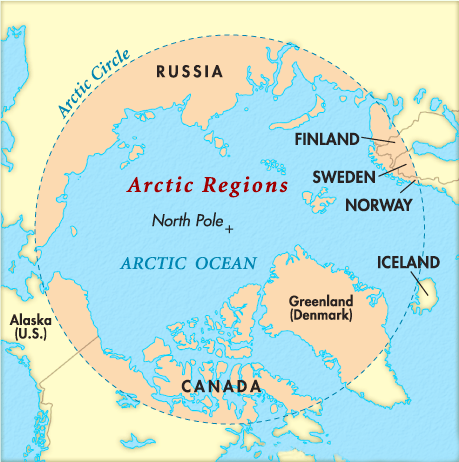Biodiversity & Environment
Arctic Sea Ice Decline
- 24 Sep 2021
- 6 min read
Why in News
Recently, the Arctic sea ice reached its minimum extent, coming in at 4.72 million square miles. It is the 12th lowest on record and the record minimum melting of the ice occurred in 2012.
- September marks the end of the summer sea ice melt season and the Arctic sea ice minimum, which means when sea ice over the Northern Hemisphere ocean reaches its lowest extent of the year.
- The ‘Last Ice Area’ (LIA), located in the Arctic’s Ice north of Greenland, has also started melting earlier than what the scientists had expected.
Key Points
- About:
- Sea ice cover has dropped by roughly half since the 1980s as a direct result of increased carbon dioxide from human activities.
- In recent years, Arctic sea ice levels have been at their lowest since at least 1850 for the annual mean and in at least 1,000 years for late summer, according to the Intergovernmental Panel on Climate Change (IPCC).
- It concluded that the Arctic is likely to be practically sea ice free in September at least once before 2050.
- At this stage of the melt season, the sea ice pack is at its weakest and is highly responsive to the weather conditions of a given day or week. Subtle shifts can have big impacts.
- Sea ice cover has dropped by roughly half since the 1980s as a direct result of increased carbon dioxide from human activities.
- Factors Causing Rapid Melting of Ice:
- Albedo Feedback Loop:
- Ice is more reflective (has a higher albedo) than land or water surfaces, this is one of several reasons for the Arctic’s warming about three times faster than the planet as a whole.
- Therefore, as global ice cover decreases, the reflectivity of Earth’s surface decreases, more incoming solar radiation is absorbed by the surface, and the surface warms.
- Ice is more reflective (has a higher albedo) than land or water surfaces, this is one of several reasons for the Arctic’s warming about three times faster than the planet as a whole.
- Darker Ocean Surface.
- The Arctic's bright ice is replaced by a darker open ocean surface, less of the sun’s radiation is reflected back to space, driving additional heating and ice loss.
- Counterclockwise Ice Circulation:
- Cyclones entering the Arctic from Siberia generated counterclockwise winds and ice drifts.
- This pattern generally reduces the amount of sea ice moving out of the Arctic through the Fram Strait, east of Greenland. This likely contributed to the record low summer sea ice conditions observed in the Greenland Sea.
- Low Pressure System:
- The low pressure system also increases cloudiness over the Arctic.
- Clouds generally block incoming solar radiation, reducing sea ice melt, but they can also trap heat lost from the surface, so their impact on sea ice melt can be a mixed bag.
- Albedo Feedback Loop:
- Impact of Melting Arctic Ice
- Global Climate Change:
- The Arctic and Antarctic act like the world’s refrigerator. They balance out other parts of the world that absorb heat. The loss of ice and the warming waters will affect sea levels, salinity levels, and current and precipitation patterns.
- Danger to Coastal Communities:
- Global average sea level has risen by about 7-8 inches since 1900, and it’s getting worse.
- Rising seas endanger coastal cities and small island nations by exacerbating Coastal Flooding and storm surge.
- Food Security:
- Polar vortexes, increased heat waves, and unpredictability of weather caused by ice loss are already causing significant damage to crops on which global food systems depend.
- Loss of Methane Store:
- Permafrost in the Arctic region (ground that is permanently frozen) stores large amounts of methane, which is a greenhouse gas that contributes to climate change.
- As more quickly the arctic ice is lost, more rapidly permafrost will melt. This will result in a vicious cycle that may result in a climate catastrophe.
- Biodiversity Threat:
- Melting of the Arctic ice puts the Arctic region’s vibrant biodiversity under serious threat.
- Global Climate Change:
Way Forward
- The Arctic is an essential system like the Amazon forest, lungs of the world, it feeds into global climate change everywhere. Therefore, it is in humanity’s interest to treat the Arctic melting as a severe global issue and act accordingly.
- The sea-ice loss at such a high rate is a matter of concern for all the lives on Earth. Thus, maintaining the balance between anthropological activities and carrying capacity of the environment is one of the foremost steps that can be taken at this point of time.







